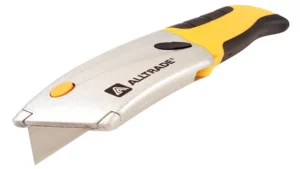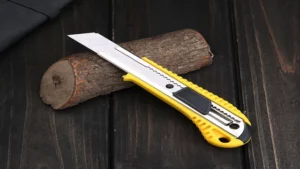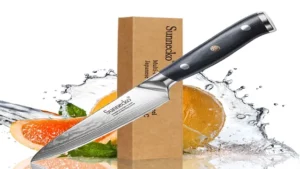Are you having a hard time distinguishing a carpet knife from a utility knife? Do you know that both are essential tools for every DIYer? Although both knives are designed for cutting, they differ in their usage, blade shape, and material. So, what’s the difference between a carpet knife and a utility knife? Let’s find out! A carpet knife is a specialized cutting tool used mainly for cutting carpets, vinyl flooring, and other similar materials. Unlike a utility knife with its straight blade, a carpet knife sports a curved or hooked blade that makes it easier to cut through thick materials.
This blade shape also allows the user to make precise cuts on a carpet without damaging the underlying surface. On the other hand, a utility knife is an all-purpose cutting tool used for everything from cardboard to wood, plastic, and more. Most utility knives come with interchangeable blades, allowing users to switch between blade types depending on the material being cut.
The blade of a utility knife is usually straight and sharp, making it ideal for slicing and cutting through a variety of materials. In summary, the difference between a carpet knife and a utility knife lies in the blade shape and its intended use. While a carpet knife’s curved or hooked blade is suited for cutting carpets, a utility knife’s straight blade and interchangeable blades make it a versatile tool for any cutting job.
Whether you’re a DIY enthusiast or a professional, having both a carpet knife and a utility knife in your toolkit can help you tackle any project with ease.
Overview
When it comes to cutting carpets and other flooring materials, a carpet knife and a utility knife may seem like interchangeable tools, but there are a few key differences that set them apart. First and foremost, a carpet knife typically features a longer and sharper blade, specifically designed to cut through thick carpet fibers and padding. Additionally, carpet knives often have a more ergonomic grip and a wider blade for added control and precision during cuts.
On the other hand, a utility knife is typically used for more general purposes, such as opening boxes or cutting through thinner materials like cardboard or plastic. Utility knives have a shorter blade and a sturdier construction, making them better suited for everyday tasks rather than precision carpet cutting. So, when it comes to choosing the right tool for the job, it’s important to consider the materials you’ll be cutting and the level of precision required.
If you’re working with thick carpeting and need clean, accurate cuts, a carpet knife is the way to go. However, if you’re just looking for a general purpose cutting tool, a utility knife may be a better fit.
Explanation of Carpet Knife
A carpet knife, also known as a carpet cutter, is a tool used to cut carpet to size and shape. Designed with a sharp blade and a sturdy handle, this tool can easily slice through carpet fibers, allowing you to create precise cuts. It’s an essential tool for anyone looking to install new carpet or replace an existing one.
The carpet knife helps users avoid frayed edges and tattered seams, making it easier to install the carpet. It’s a versatile tool that can be used on a range of carpet types, including loop pile carpets, Berber carpets, and Saxony carpets. With its ergonomic handle and sharp blade, it’s easy to get the job done right the first time.
So, if you’re looking for an efficient tool to help you with your carpeting project, a carpet knife is definitely worth investing in.

Explanation of Utility Knife
A utility knife is a versatile cutting tool that can be used for a variety of purposes. Its blade is designed to be sharp and durable, able to handle tough materials like cardboard, plastic, and even carpet. The handle is typically made of a sturdy material like plastic or metal, and may have a simple, ergonomic design to make it comfortable to hold.
Utility knives come in different shapes and sizes, with some featuring retractable blades for added safety. They are commonly used for tasks like opening boxes, slicing through packing tape, trimming wallpaper, and cutting ropes and cords. Overall, a utility knife is a valuable tool to have in any toolbox or home, thanks to its flexibility and durability.
Blade Styles
When it comes to cutting materials, there are a variety of blade styles to choose from. One common question people may have is how a carpet knife differs from a utility knife. The answer lies in the shape of the blade itself.
A carpet knife typically has a hooked blade that curves downward, which allows for precise cuts when working with carpet or other fabrics. On the other hand, a utility knife often has a straight blade that can be used for tasks such as cutting cardboard, plastic, or opening boxes. The shape of the blade affects the function and purpose of each knife.
So, if you are working with carpet or other fabrics, a carpet knife may be the better choice as it will provide better precision and accuracy. However, if you need a knife that can handle a variety of materials, a utility knife may be more versatile. Knowing the difference between these blade styles will help you choose the right tool for the job.
Carpet Knife Blade Style
When it comes to carpet knives, there are various blade styles to choose from. Each blade style has its unique features and benefits. The most common blade style is the hook blade.
It has a curved tip that helps to catch and cut through carpet fibers. The hook blade is capable of making precise cuts, and it’s great for trimming carpet edges. Another blade style is the straight blade.
It has a straight edge and is perfect for cutting through carpet padding and other types of flooring materials. The straight blade can also be used for scoring drywall or cutting cardboard. The double-sided blade is another option that features two sharp edges, making it a versatile choice for various cutting tasks.
Lastly, there’s the concave blade, which is excellent for removing carpet from stairs or other uneven surfaces. So, when choosing a carpet knife, consider the blade style that suits your needs and the application you’ll be using it for.
Utility Knife Blade Style
When it comes to utility knife blades, there are several blade styles to choose from, each with its own unique purpose. The most common blade type is the straight blade, which is perfect for slicing and cutting through a variety of materials. The serrated blade, on the other hand, features a jagged edge that can easily cut through tougher materials like rope, leather, and fabric.
Hook blades are designed for cutting through carpeting and other soft materials, while curved blades are ideal for slicing through tougher materials like plastic and PVC. Additionally, there are specialized blade styles like the chisel blade, which is perfect for removing grout, and the sheepsfoot blade, which is ideal for cutting and trimming carpet and other types of fabric. When choosing a utility knife blade style, it’s important to consider what materials you will be cutting and what tasks you need to accomplish.
With the right blade, a utility knife can be an invaluable tool in any tool kit or workshop.
Uses
If you’re wondering how a carpet knife is different from a utility knife, there are a few key differences to keep in mind. First and foremost, the blade on a carpet knife is designed to be long and sharp, perfect for cutting through thick carpet fibers. In contrast, a utility knife has a shorter blade that is ideal for cutting through thinner materials like cardboard or plastic.
Another difference is in the handle. A carpet knife typically has a larger and more ergonomic handle to help provide better control and reduce hand strain during extended use. On the other hand, a utility knife often has a smaller, more compact handle that is easier to store in a tool belt or toolbox.
Overall, while both knives have similar uses, they are designed with different purposes in mind and are better suited for specific tasks depending on the material being cut.
Carpet Knife Uses
Carpet Knife Uses Carpet knives are versatile tools that can be used for a wide variety of purposes. They are commonly used for cutting carpets, but they can also be used for cutting other materials such as vinyl, linoleum, cardboard, and more. These knives are designed to be very sharp and precise, making them ideal for cutting even the thickest and toughest materials.
They are also designed to be very durable and long-lasting, so you can use them for years to come. Whether you are a professional carpet installer or just a DIY enthusiast, a carpet knife is an essential tool to have in your toolkit. With the right knife, you can cut carpets with ease and precision, and make clean and accurate cuts every time.
You can also use a carpet knife to cut other materials such as cardboard, foam, and even leather. One of the best things about carpet knives is that they are relatively inexpensive and easy to find. You can purchase them at any hardware store or online, and they are available in a wide range of sizes and styles to suit your needs.
Whether you need a small knife for detail work or a larger knife for cutting thick materials, there is a carpet knife out there for you. In conclusion, a carpet knife is a must-have tool for anyone who works with carpets or other materials. From cutting carpets to creating precise cuts in other materials, a carpet knife is an essential tool that will make your work easier and more efficient.
So if you don’t already have one, it’s time to add a carpet knife to your toolkit!
Utility Knife Uses
Utility Knife Uses Utility knives are one of the most versatile cutting tools that everyone should have. There are so many uses for a utility knife that it may seem like an all-purpose tool. From opening boxes to trimming wallpaper, a utility knife provides a perfect solution.
The blade is incredibly sharp and compact, making it easy to navigate through tight spaces. One of the most common uses of a utility knife is for crafting. The sharp blade allows for precise cuts, clean lines, and intricate designs.
Additionally, utility knives are great for cutting carpet, drywall, and foam insulation. The utility knife is also used to cut through materials such as cardboard, plastic, and even some metals. This makes it an indispensable tool for DIY projects, hobbies, and home repairs.
If you’re an outdoor enthusiast, a utility knife is also a great camping tool. Whether it’s preparing food or opening cans, the blade makes quick work of any task. A utility knife is truly an all-purpose cutting tool that is a must-have for everyone.
Safety Measures
When it comes to cutting materials, safety should always be your top priority. Whether you’re a professional carpet installer or a DIY enthusiast, it’s crucial to use the right tool for the job. A carpet knife, also known as a carpet cutter, is specifically designed to cut through carpet fibers with precision and ease.
On the other hand, a utility knife is a multi-purpose tool that can come in handy for a variety of cutting tasks. The key difference between the two is in the blade. A carpet knife usually has a thicker, rounded blade that is less likely to break or slip, while a utility knife features a thinner, sharper blade that can easily puncture skin or other materials if not handled properly.
Therefore, if you’re working with carpet or other soft materials, opt for a carpet knife to ensure a safe and efficient cut. And, remember always to wear protective gear such as gloves and safety glasses when handling sharp tools.
Carpet Knife Safety
Carpet knife safety is a critical aspect that should be taken seriously to prevent accidents and injuries. It is essential to follow some safety measures when using a carpet knife to ensure personal safety. One of the first things to do is to make sure that the blade is sharp enough to cut through the carpet easily.
A dull blade increases the risk of slipping, which can lead to accidental cuts. It is also important to wear protective gear when using a carpet knife, such as gloves and goggles. This will prevent any debris or dust from getting in your eyes and will provide better grip while cutting.
Before using a carpet knife, it is crucial to inspect the blade for any damages or signs of wear and tear. In case of any defects, replace the blade immediately. It is also essential to keep the blade locked away in a safe place when not in use to ensure that it is not accessible to children or anyone who is not supposed to handle it.
Protect yourself and others by following these simple safety measures when using a carpet knife.
Utility Knife Safety
When working with a utility knife, there are certain safety measures that you should always keep in mind to avoid potential accidents. First and foremost, it’s important to use a sharp blade as it’ll require less pressure and therefore decrease the chances of slips or jerks. Always make sure that you have a good grip on your knife-handle and keep both your fingers and thumb away from the blade’s path.
It might be tempting to use your free-hand to hold the object you’re cutting, but that increases the risk of a serious injury, so it’s best to use a stable cutting surface. Make sure to always cut away from your body and be aware of your surroundings to avoid getting distracted or bumped into. Lastly, never try to catch a falling knife or leave it carelessly on a surface, always put it away in a safe place.
By following these safety measures, you can ensure that your work with a utility knife is productive and hazard-free.
Conclusion
In the world of tools, the choice between a carpet knife and a utility knife can be a cutthroat decision. While both share some similarities, they are fundamentally different in their design and purpose. A carpet knife is sharper, stronger, and more durable with a specialized blade that can easily cut through thick carpets and other tough materials.
On the other hand, a utility knife is a jack of all trades, able to handle different cutting tasks with its interchangeable blades and compact size. So if you’re looking to cut through the competition, choose the right tool for the job and don’t get stuck between a rock and a hard place – or should we say a carpet and a cardboard box?”
FAQs
What is a carpet knife?
A carpet knife is a type of cutting tool specifically designed for cutting and trimming carpet.
What is a utility knife?
A utility knife is a general-purpose cutting tool that can be used for a variety of tasks such as cutting boxes, ropes, and other materials.
How is a carpet knife different from a utility knife?
A carpet knife has a hooked blade for cutting carpet fibers while a utility knife has a straight blade for general cutting purposes.
Can a carpet knife be used for general cutting tasks?
While a carpet knife is designed for cutting carpet specifically, it can still be used for general cutting tasks. However, it may not be as efficient or effective as a utility knife.
Is a carpet knife more dangerous than a utility knife?
Both tools can be dangerous if not used properly. However, a carpet knife’s hooked blade may be more prone to accidental cuts and injuries compared to a utility knife’s straight blade.
Do carpet knives and utility knives come in different sizes?
Yes, both tools come in various sizes to accommodate different cutting needs and preferences.
Which type of knife should I use for cutting carpet padding?
A utility knife is typically more suitable for cutting carpet padding due to its straight blade and versatility.






